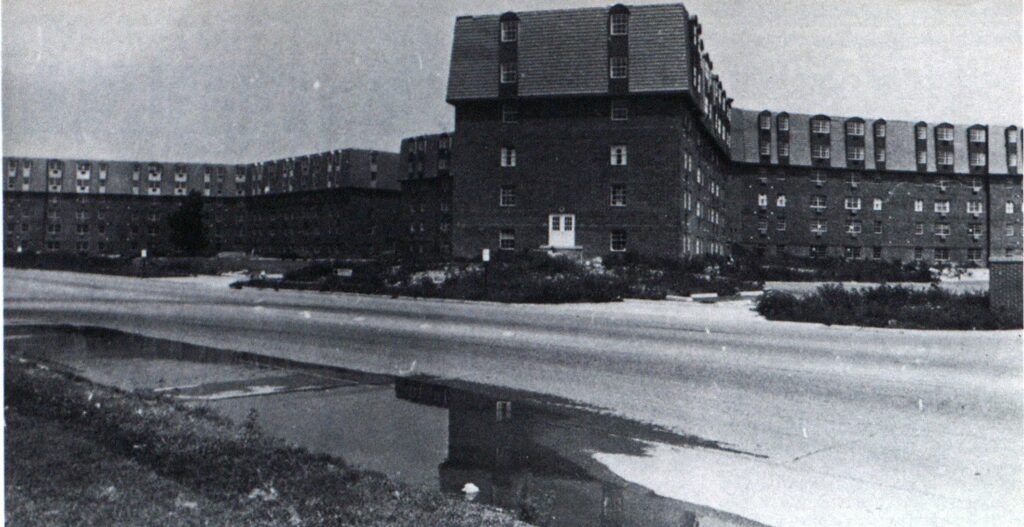
$3 Million Project Demolished After Code Victory
features
After five years of legal battles, two six-story, wood frame with brick veneer apartment houses were demolished in Prairie Township, Ohio, before they were occupied because they were judged to be in violation of fire-safety provisions of the state building code.
The $11 million Reacon Club Towers construction project was labeled “Toothpick Towers” by Prairie Township fire fighters, who fought two fires there. The Prairie Township Fire Department, headed by Chief John R. Richards, has six paid men and 40 volunteers. Prairie Township, adjoining Columbus on the west, has apartment complexes, shopping centers, motels and other commercial developments, as well as farm land.
Baldwin Homes, Inc. of Columbus on September 16, 1968, obtained approval for two six-story, wood frame, balloon construction buildings with aluminum wiring throughout. Each building was to contain 132 apartments. Approval was granted by the Ohio State Building Department through an erroneous interpretation of the generally respected state building code. The developers contended that the use of fire-retardant wood structural members was the equivalent of noncombustible steel construction.
Wood stair platforms
Construction commenced at the 5acre site and Richards made constant inspections. Plans called for one elevator, 4X6 feet, to serve 132 apartments on six floors. Metal fire stairs at the six extremities of the two wye-shaped buildings had plywood landings. The fire doors to the stairwell, when open, blocked the use of fire hose connections at the end of each corridor. There was no stairwell in the center core of the wye. If fire had blocked one stairwell, a person would have had to travel 250 feet through corridors constructed of combustible material to reach another.

Dispatch photo

Photo by Frank L. Brannigan

Photo by Frank L. Brannigan

Dispatch photo by Ken Chamberlain. Jr.

Photo by Frank L. Brannigan
A huge heating boiler and three large water heaters rested on concrete slabs on the top floor of each building. Each building had a mansard roof constructed mostly of plywood with an inadequate fire wall at each wing.
The most obvious deficiency was inferior workmanship and slipshod construction. Fire walls had glaring gaps. Plumbing and electrical installation was accomplished by punching holes through gypsum board twice the size needed for piping and wiring.
The architectural deficiencies, the fire-stopping, and open spaces created by sloppy craftsmanship raised the specter of a fire developing into a fire storm if fanned by the westerly winds of Prairie Township.
Apartments on three sides of the two six-story buildings and a shopping center to the south were endangered.
“Built to burn”
Two fires at the site during 1971 exhausted the patience of Richards, who said, “These buildings were built to burn.”
The chief was faced with the fact that wiring deficiencies and inadequate fire-stopping were rapidly being covered up by interior partitions and combustible trim. The first 132-unit apartment of the $3 million complex was 80 percent complete and could have been partially occupied within 30 days. The second was 60 percent complete.
Richards fired the first volley of a five-year legal battle by issuing a fire chiefs order in January 1972 to stop construction. He ordered the top floors to be removed and all other building code requirements to be met or the structure to be razed and material removed. This order was personally typed by the chief.
Baldwin Homes, Inc. of Columbus, a part of Fortune Fund Financial Corporation. headed by millionaire developer Julius J. Cohen, turned all its financial and legal resources into the battle against the chief and appealed to the state fire marshal.
The chief turned to the resourceful young prosecutor for Franklin County, George C. Smith, for legal support. At the hearing before the state fire marshal, the chiefs order was sustained. Cohen promptly appealed to t he courts.
Injunction obtained
Meanwhile, prodded by Richards, inspectors of the State Building Inspection Department issued an order in February 1972 that listed 23 building code violations. They were mainly electrical, fire wall and fire-stopping deficiencies. Faulty supervision resulted in the use of huge quantities of untreated wood, which the order required to be replaced. This order was not affirmed until November 1975.
Smith obtained an injunction, as prosecutor, for violat ions of the zoning code. This case was twice appealed to the Court of Appeals and once to the Supreme Court of Ohio. Smith prevailed all the way.
Richards and Smith did not lose a round in any of the five years of legal battles. At various times the developers and their attorneys offered compromise settlements. The last offer was to raze one building and fully sprinkler the second. The offer was refused.
Prairie Township fire prevention officer, Lt. Robert A. Kunz, summed it up, “That would only kill half as many people.”
The building corporation finally folded its operations and abandoned further legal battles. Richards’ perseverance paid off when the structures were demolished under a county contract last August.

—Photo by Frunk L. Brannigan

